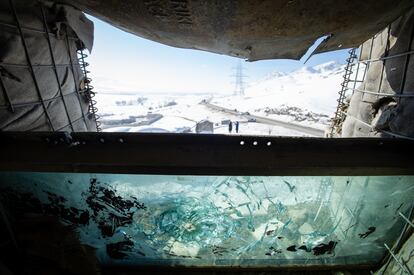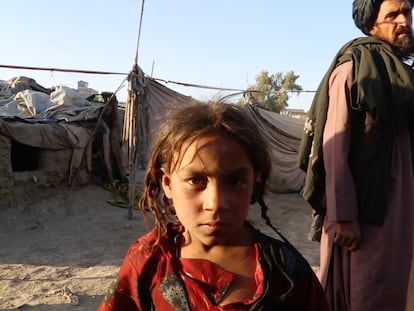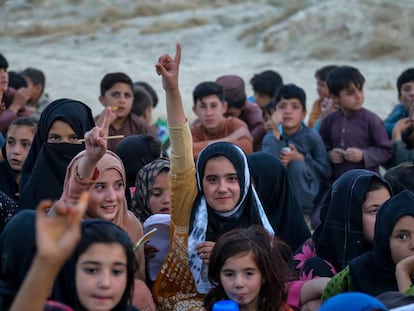Millions of Afghans face winter with just one meal a day
Foreign aid cuts require citizens to make tough decisions in forgotten areas of Afghanistan due to food shortages and harsh weather conditions

In recent months, 22-year-old Sabar Gol has had to spend more time letting her neighbors down than handing out bags of rice and wheat, as she carries the burden of determining who among Behsud district’s 250,000 people can possibly be cut from distribution lists.
Taliban restrictions keep Sabar, a high school graduate in this remote district of Afghanistan’s Maidan Wardak province, from studying in university and working in many jobs, but she feels compelled to find a way to assist no matter what.
“I have to help in any way I can. I have to serve my people,” the local volunteer told The New Humanitarian in mid-October.
As 2023 wore on, international aid organizations confronted growing concern over who they would be able to assist during Afghanistan’s brutal winter months, with their budgets being slashed due to the global economic downturn.
This came to a head from October when back-to-back events forced them to balance the existing needs of the 15.8 million Afghans already facing food insecurity with the new needs of millions more displaced by disasters and forced evictions from neighboring countries.
When the western province of Herat was struck by the first in a series of earthquakes on the morning of 7 October, it was only a few days after the caretaker government of Pakistan announced its plan to deport up to a million Afghans it said had been living in the country without proper documentation. It was also just after 25 government-run hospitals lost their international funding and the World Food Programme announced it would have to cut more than 10 million Afghans from its assistance operations.
These shocks compounded existing aid budget shortfalls, and for many Afghans, especially those living in remote areas, they are having a very real impact on their lives, particularly in the winter months when travel — and therefore work opportunities — are greatly hindered for weeks, sometimes months, at a time.
Amid a global aid budget crunch driven by inflation and the war in Ukraine, the UN’s humanitarian response plan for Afghanistan was only 45.4% funded in 2023, well below the 75.7% that donors managed in 2022 and typical levels of funding over the last decade.

Coming from a seven-person farming family in what has long been one of Maidan Wardak’s least-developed areas, Sabar knows just how much communities have come to depend on assistance like the WFP food rations.
As a woman, Sabar sees some of the most desperate people in Maidan Wardak — one of the most conflict-prone provinces during the 20-year rule of the former Western-backed government. She said 70% of the families she sees — like hers — lack a male breadwinner.
“I can tell you that 100% of the people I speak to need this assistance in full,” Sabar said, standing outside a WFP distribution site. “Most people don’t have an income anymore.” She said almost every family she encounters has breastfeeding women and children to care for.
No work in the city
This year, the UN projects that nearly 24 million Afghans will be in need of humanitarian assistance, a notable decrease from last year’s 29 million, but a figure the UN still feels will lead to hard choices as aid budgets continue to slide.
“Limited funding has and will continue to force humanitarian actors to prioritize those most vulnerable and in need,” the UN’s emergency aid coordination body, OCHA, said, outlining the response challenges for the year ahead in Afghanistan.
Cities may have borne the brunt of most of the more than 700,000 job losses since the Taliban’s Islamic Emirate returned to power in August 2021, but Afghans in rural areas have also had to deal with the drastic implications of flooding, droughts, and earthquakes. This has decimated the productivity of farmland even as the foreign aid they receive continues to shrink.
Mohammad Mehdi Ahmadi, a wheat farmer, said that in a largely agricultural economy like Behsud, the impacts of disasters can stretch out for months, even years, at a time. The 30-year-old said that flooding over the last two years had damaged more than 1,000 homes and wiped out some farmers’ entire crops.
Due to the combination of the floods and the cutbacks to aid, families are now “forced to choose between eating [their one meal] during the day or at night”, he said.
In the past, Ahmadi said that when boys entered their teenage years, they would be sent to Kabul or other cities to work as day laborers. However, with roughly a million Afghans being deported from Pakistan, Iran, and Türkiye over the last year, the nation’s urban centers are under increased strain and the work just isn’t there anymore.
Despite more restrictive immigration policies from Islamabad, Tehran, and even Ankara, Ahmadi said Afghans are still trying to leave the country in the hope of finding work.
“This year, from every village, two, three people have gone to Iran,” Ahmadi said, adding that, with 720 villages in the district, the exodus has had a major impact on the earning potential of thousands of households. The best the poorest can hope for, he said, is to try and relocate to another district closer to the provincial capital, Maidan Shahr, or Kabul.
The district’s residents say Behsud’s location, in a remote valley in the central highlands, greatly affects their ability to earn a living. Ahmadi’s own village is a three-hour motorcycle ride from the center of the district.
Behsud is one of the coldest districts in Afghanistan, with winter temperatures dropping to the minus double digits Celsius and the cold weather often lasting from mid-September right through to April.
Even by October, residents say the cold hinders their ability to farm. “From this point on, not one person will be able to earn even a single afghani,” said one farmer, Abdul Razaq.
The need to rethink aid
Ahmadi, the wheat farmer, said WFP assistance over the last two years — when food aid was still distributed across almost the entire district— had a major impact in Behsud beyond just its nutritional value.
“Their help took the men from the fields to the classrooms,” he said, explaining how it allowed children to spend more time in school instead of working to help their families get by.
Even when roads open in the warmer months, many children aren’t in school because they or their parents are too busy carpet weaving and working in other people’s homes, according to 28-year-old teacher Abdur Rahman.
“Most children in Behsud are only partially educated. They aren’t illiterate, but they’re also not properly educated. Most of them are in and out of school,” he said, speaking by phone this week.
With WFP only able to reach one out of every five needy Afghans due to the budget cuts, Dayne Curry, country director of Mercy Corps, said international NGOs need to rethink their approach to distributing aid. “It’s not a question of having tons of money. It’s about using what money you have really strategically,” he told The New Humanitarian.
Curry is urging Mercy Corps and other organisations to think longer-term.
“We have to remind donors that short-term assistance is great, [but] that this should be the year to focus on resilience,” he said, speaking by phone last week. “It’s time to focus on how people can produce food for themselves, have water for themselves.”
Amid all the budget cuts and attention shifting towards places like Gaza, Curry said he has been heartened to see local groups picking up the slack for foreign aid organizations, which are often hampered by bureaucracy and shifting global priorities.
“Afghan local communities, organizations, and businesses are trying to pull together whatever they can to help their people,” said Curry, recalling how he had witnessed local volunteers and businesses providing tents and hot meals to people whose homes had been destroyed by the earthquakes in Herat.
One Afghan-run business that has consistently assisted those in need is Aseel — a platform that enables online donors to purchase aid packages for needy families.
Earlier this winter, the founder, Nasrat Khalid, returned to Afghanistan for the first time in several years to bear witness to the growing needs and assist people first-hand.
In its new campaign, launched in late December, Aseel had by this week already managed to reach 206 families, comprising more than 2,100 people, including more than 200 children.
Upon his return to Kabul, a city he knows well from growing up there, Khalid told The New Humanitarian the “poverty was definitely very noticeable”, and driven by the lack of proper livelihoods and quality jobs.
Rahman, the teacher from Behsud, put it more simply: “The aid is a little and the need is great.”
Sign up for our weekly newsletter to get more English-language news coverage from EL PAÍS USA Edition
Tu suscripción se está usando en otro dispositivo
¿Quieres añadir otro usuario a tu suscripción?
Si continúas leyendo en este dispositivo, no se podrá leer en el otro.
FlechaTu suscripción se está usando en otro dispositivo y solo puedes acceder a EL PAÍS desde un dispositivo a la vez.
Si quieres compartir tu cuenta, cambia tu suscripción a la modalidad Premium, así podrás añadir otro usuario. Cada uno accederá con su propia cuenta de email, lo que os permitirá personalizar vuestra experiencia en EL PAÍS.
¿Tienes una suscripción de empresa? Accede aquí para contratar más cuentas.
En el caso de no saber quién está usando tu cuenta, te recomendamos cambiar tu contraseña aquí.
Si decides continuar compartiendo tu cuenta, este mensaje se mostrará en tu dispositivo y en el de la otra persona que está usando tu cuenta de forma indefinida, afectando a tu experiencia de lectura. Puedes consultar aquí los términos y condiciones de la suscripción digital.
More information
Últimas noticias
Most viewed
- Reinhard Genzel, Nobel laureate in physics: ‘One-minute videos will never give you the truth’
- Oona Chaplin: ‘I told James Cameron that I was living in a treehouse and starting a permaculture project with a friend’
- Pablo Escobar’s hippos: A serious environmental problem, 40 years on
- Why we lost the habit of sleeping in two segments and how that changed our sense of time
- Charles Dubouloz, mountaineering star, retires at 36 with a farewell tour inspired by Walter Bonatti










































